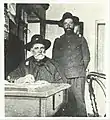| Revolution of 1904 | |||||||
|---|---|---|---|---|---|---|---|
 Clockwise from top left: Last photograph of General Aparicio Saravia, taken during the revolution, | |||||||
| |||||||
| Belligerents | |||||||
|
|
| ||||||
| Commanders and leaders | |||||||
|
Aparicio Saravia Abelardo Márquez Dionisio Viera José González Bernardo Gervasio Berro Manuel Macedo Basilio Muñoz José María Pampillón |
José Batlle y Ordóñez Eduardo Vázquez Manuel Benavente Justino Muniz Pablo Galarza Guillermo Buist Basilicio Saravia Oscar Muñoz Caravia | ||||||
| Units involved | |||||||
| Blanco Army | Government Army | ||||||
| Strength | |||||||
| 10,000 | 25,000 | ||||||
The Revolution of 1904 was a civic-military revolt led by Aparicio Saravia against the government of José Batlle y Ordóñez in Uruguay.[1] It was the last military conflict between Blancos and Colorados.[2]
History
It was the bloodiest of the revolutions that occurred in Uruguay, with large numbers of casualties and injuries on both sides. On June 6, 1904, took place the Battle of Guayabos (Salto Department), in which the saravista colonel Abelardo Márquez, was defeated by government troops.[3]
In the Battle of Tupambaé, General Aparicio Saravia faced the troops of General Pablo Galarza in the department of Cerro Largo.[4] Saravia was wounded during the Battle of Masoller, and died several days later in Santana do Livramento, Brazil.[5] The armistice was signed on September 24, 1904.[6]
Several sons of Aparicio Saravia fought in the ranks of the revolutionary army. His brother Basilicio Saravia, served in the government army.[7]
Gallery
 Colonel Manuel Macedo Fuliáo, and sons during the Revolution of 1904
Colonel Manuel Macedo Fuliáo, and sons during the Revolution of 1904 shooting practice of Saravistas forces
shooting practice of Saravistas forces José F. González, colonel saravista
José F. González, colonel saravista Basilicio Saravia head of one of the divisions of the Uruguayan army
Basilicio Saravia head of one of the divisions of the Uruguayan army Guillermo Buist, colonel of government forces
Guillermo Buist, colonel of government forces General Eduardo Vázquez of Uruguayan Army
General Eduardo Vázquez of Uruguayan Army shooting practices of government army forces
shooting practices of government army forces
References
- ↑ Aparicio Saravia en la Revolución de 1904. Florensa & Lafon, 1949. 1949.
- ↑ Historia de la revolución, 1904: espisodios, grabados, etc. Montevideo. 1904.
- ↑ Aparicio Saravia en la Revolución de 1904. Florensa & Lafon, 1949. 1949.
- ↑ Saravia en el bronce: símbolo de libertad. Impr. Adroher, 1956. 1956.
- ↑ Anales, Volumen 151. Universidad de la República (Uruguay). 1942.
- ↑ Memorias de Aparicio Saravia: relato histórico biográico de su hijo Nepomuceno, ilustrado con la doumentación del archivo del general. Nepomuceno H. Saravia, Nepomuceno Saravia Garcia. 1956.
- ↑ Aproximación a la obra de Javier de Viana: análisis del cuento La vencedura. Margarita Assunção de Garretano. 1982.